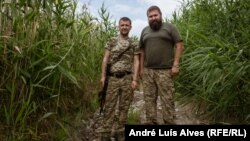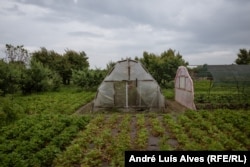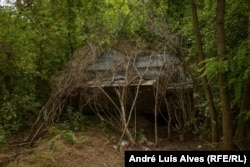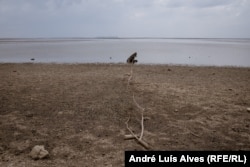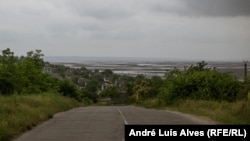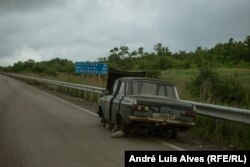KAMYANSKE, Ukraine -- The river flowing through this village in the Zaporizhzhya region separates territory controlled by Ukrainian and Russian forces and then flows into the Kakhovka reservoir, now almost empty after the breach of the big dam downstream on the Dnieper.
It is here -- on the destroyed bridge that spanned the Yanchekrak River, just 30 kilometers south of the regional capital -- that Ukrainian troops halted the Russian advance after Moscow launched its full-scale invasion in February 2022.
The exchange of fire that has been ongoing since then turned Kamyanske into a wasteland, with most of its buildings destroyed and hunks of shrapnel and rubble lying all around. Now, as Ukraine's long-anticipated counteroffensive kicks into gear, the sounds of artillery and rocket launchers never seem to stop.
From Kamyanske, the road south leads to the strategic, Russian-held cities of Tokmak and Melitopol, crucial for cutting through the "land bridge" that stretches east to the border, allowing Russia to supply occupied Crimea as well as Enerhodar, the city linked to the Zaporizhzhya nuclear power plant, Europe's largest, which Russia seized shortly after the invasion, in early March 2022.
Kamyanske seems eerily empty: Neither residents nor soldiers are easy to spot, and often the only moving objects are the drones flying above. With scarce information and contradictory reports about the fighting on Ukraine's 1,000-kilometer front line, it is not clear whether and how far have the Ukrainian forces advanced here.
Broken Silence
Faced with high expectations and complex objectives, Ukraine launched an information campaign urging silence ahead of the counteroffensive. A video released in early June by the Defense Ministry showed camouflage-clad soldiers putting a finger to their lips -- Shhh! -- and displayed slogans "Plans like silence" and "The beginning will not be announced."
Shortly afterward, the counteroffensive started.
Some of the first reports about it came from the Russian Defense Ministry and nationalist Russian military bloggers, some of whom have close ties to military units or security agencies.
On June 5, the ministry said the Ukrainian military launched an attack around the village of Novodonetske, located between Velyka Novosilka and Vuhledar in the Donetsk region, the site of a large and disastrous Russian offensive in winter, and claimed Ukraine suffered heavy losses. The claims could not be independently verified, and reports by bloggers presented a mixed picture.
On June 8, Russian sources reported a Ukrainian attack in a heavily fortified area near Orikhiv, some 30 kilometers east of Kamyanske. Footage purportedly showing destroyed and damaged Western weapons appeared online. Russia's defense minister again claimed Ukrainian troops suffered heavy losses.
After these reports spread on Ukrainian social media, a widely known officer in the Ukrainian unit involved, Sergeant Valeriy Markus, dismissed the Russian claims in an emotional video -- an unusual breach of a rule banning public comment on combat operations by military personnel. He asserted that Russian losses were "many times bigger."
"On the first day, when they [Russian sources] announced that our brigade was crushed, that we had 350 dead soldiers, that it was over, that our brigade no longer existed, in fact, we had only five soldiers killed. This is a shining example of how shamelessly they lie," Markus said.
Ukraine's ultimate goal, President Volodymyr Zelenskiy says, is to drive Russian forces from all of Ukraine including Crimea, which Russia occupied in 2014. In addition to Crimea, Russian forces occupy parts of the Donetsk, Luhansk, Zaporizhzhya, and Kherson regions, and the Kremlin baselessly claims those regions are now part of Russia.
The counteroffensive has led to increased fighting on several parts of the front line, which runs northeast from near Kherson and the Dnieper delta to the Donbas and part of the Kharkiv region. Attempts to advance into Russian-occupied territory put Ukrainian troops at risk from Russian artillery and air attacks as they move from their positions and from protection of air defense systems.
Mykola Byelyeskov, an analyst at Ukraine's National Institute for Strategic Studies, told RFE/RL on June 13 that so far attempts to break thorough Russian lines have turned into grinding battles in several areas of southern Ukraine. "This means that we are still within the offensive's first phase," he said.
Byelyeskov also said most of the Ukrainian and Russian units deployed at the front were formed after the February 2022 invasion.
"It's always a challenge to turn mobilized [draftees] into a fighting force. That proved true with regards to Russia, and there is no reason not to expect the same challenge in the case of Ukraine," he said.
East of Zaporizhzhya and Kamyanske, Ukrainian forces have advanced on a part of the front close to Velyka Novosilka, a town near the administrative border between the Zaporizhzhya and Donetsk regions. On June 10 and 11, Ukraine said its forces liberated four villages along the Mokriy Yaly River south of Velyka Novosilka: Makarivka, Neskuchne, Blahodatne, and Storozheve.
Later, on June 12, Ukraine said its forces took control of the villages of Levadne and Novodarivka, 10 kilometers to the west, although Russian officials said Ukrainian forces had been repelled in some of those areas.
Ukrainian security expert Pavlo Lakiychuk told RFE/RL that Ukrainian forces have been probing Russian defenses with "tactical" strikes but that there are no indications that they reached the main defense lines -- which include minefields, lines of dragon's teeth, and large anti-vehicle trenches.
"The main forces trained and equipped by Western allies are not engaged in the fighting, and the direction of the main strikes is yet to be determined," he said.
Nuclear Plant
Also on June 12, Ukraine said its forces had retaken the village of Lobkove, just southeast of Kamyanske. According to unofficial reports, the battles there lasted for several days.
With both sides understanding the stakes of controlling the roads leading both to the Zaporizhzhya nuclear power plant and Melitopol, the fierce fighting in this area is no surprise, Byelyeskov said.
Around Kamyanske, the military ambulances speeding north toward Zaporizhzhya suggested that intense fighting continued. The relative calm in the villages north of Kamyanske indicated there was no imminent threat of a Russian advance.
The picturesque village of Prymorske, about 10 kilometers north of Kamyanske and the river that bisects it, is more or less intact, and life goes on despite the battles nearby.
According to Andriy Pidhorny, who is responsible for distributing humanitarian aid to civilians in the area, two-thirds of Prymorske's more than 3,500 residents remain, and many of them continue to work.
The village sits on a steppe cut by ravines and slopes that fall to the Kakhovka reservoir, a broad section of the Dnieper that stretches to the horizon. After the June 6 breach of the Russian-controlled Kakhovka dam, at the southern end of the reservoir, the water level fell by four meters, leaving most of the bottom dry, Pidhorny said, unfurling a map from the period before the construction of the dam in 1954.
Two soldiers patrolling the shoreline, Rostyslav and Oleksandr, have watched water recede from the shore for days. "It will be possible to drive a car here when the bottom dries out, but it won't affect our job here," Oleksandr said.
The exact cause of the breach is the subject of conflicting claims, with Ukraine saying Russia most likely detonated the dam it earlier mined from the inside. Lakiychuk asserted it was a "textbook Soviet move" by the Russian command aimed at slowing down the Ukrainian counteroffensive. Russian officials claim Ukraine caused the breach but have offered no explanation as to how it might have done.
Meanwhile, retaking the Zaporizhzhya plant, also on the Kakhovka reservoir, may be a crucial goal of the counteroffensive. Ukraine will likely try to pressure Russian troops to retreat from the plant, Lakiychuk said, adding that "one cannot rule out that in the worst case, Putin will decide to bring about a nuclear catastrophe."




